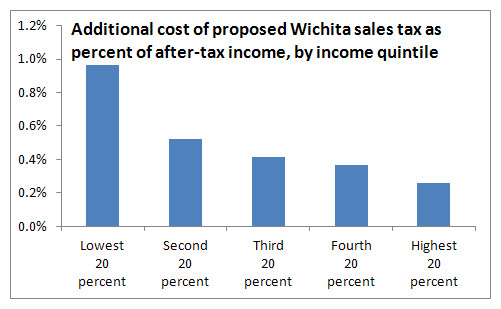Supporters of a new sales tax in Wichita use the Intrust Bank Arena as an example of successful application of a sales tax.
As Wichita debates the desirability of a sales tax, a former sales tax is used as a model of success. Let’s take a look at a few of the issues.
Ongoing vs. capital expenses
A portion of the proposed sales tax will be used for operational expenses, and the demand for this spending will not end when the sales tax ends.
The sales tax for the Intrust Bank Arena was used to build a capital asset and establish a small reserve fund. Spending on capital assets is characterized by a large expense in a short period of time as the asset is constructed. Then, the spending is over — sort of.
For the proposed Wichita sales tax, 63 percent is scheduled for capital asset spending on an enhanced water supply. The remainder, 37 percent, is for operation of the bus transit system, street repair, and economic development. These three items are operational in nature, meaning they are ongoing expenses. It’s not likely that after five years the bus system will be self-sustaining, or that streets will no longer need repair, or that there will be no more clamoring for economic development.
There is a large difference, then, between the arena sales tax and the proposed Wichita sales tax. While sales tax boosters say the tax will end in five years, the likelihood is that because much of it will have been paying for operational expenses, there will be great pressure to continue the tax and the spending it supports. That’s because the appetite for tax revenue by government and its cronies is insatiable. An example: As the arena sales tax was nearing its end, Sedgwick County Commissioner Tim Norton “wondered … whether a 1 percent sales tax could help the county raise revenue.” (“Norton floats idea of 1 percent county sales tax,” Wichita Eagle, April 4, 2007)
Intrust Bank Arena economics
Having promoted a false and incomplete picture of the economics of the Intrust Bank Arena, civic leaders now use it as a model of success.
The building of a new arena in downtown Wichita was promoted as an economic driver. So far, that hasn’t happened. There have been spurts of development near the arena. But the arena is also surrounded by empty lots and empty retail space, and there have been months where no events took place at the arena.
Regarding the accounting of the profits earned by the arena, we need to realize that civic leaders are not telling citizens the entire truth. If proper attention was given to the depreciation expense of Intrust Bank Arena, that would recognize and account for the sacrifices of the people of Sedgwick County and its visitors to pay for the arena. This would be a business-like way of managing government — something we’re promised. But that hasn’t happened.
Civic leaders and arena boosters promote a revenue-sharing arrangement between the county and the arena operator, referring to this as profit or loss. But this arrangement is not an accurate and complete accounting, and it hides the true economics of the arena. An example of the incomplete editorializing comes from Rhonda Holman of the Wichita Eagle, who earlier this year wrote “Though great news for taxpayers, that oversize check for $255,678 presented to Sedgwick County last week reflected Intrust Bank Arena’s past, specifically the county’s share of 2013 profits.”
There are at least two ways of looking at the finances of the arena. Most attention is given to the “profit” (or loss) earned by the arena for the county according to an operating and management agreement between the county and SMG, a company that operates the arena.
This agreement specifies a revenue sharing mechanism between the county and SMG. For 2103, the accounting method used in this agreement produced a profit of $705,678, to be split (not equally) between SMG and the county. The county’s share, as Holman touted, was $255,678. (Presumably that’s after deducting the cost of producing an oversize check for television cameras.)
 While described as “profit” by many, this payment does not represent any sort of “profit” or “earnings” in the usual sense. In fact, the introductory letter that accompanies these calculations warns readers that these are “not intended to be a complete presentation of INTRUST Bank Arena’s financial position and results of operations and are not intended to be a presentation in conformity with accounting principles generally accepted in the United States of America.”
While described as “profit” by many, this payment does not represent any sort of “profit” or “earnings” in the usual sense. In fact, the introductory letter that accompanies these calculations warns readers that these are “not intended to be a complete presentation of INTRUST Bank Arena’s financial position and results of operations and are not intended to be a presentation in conformity with accounting principles generally accepted in the United States of America.”
That bears repeating: This is not a reckoning of profit and loss in any recognized sense. It is simply an agreement between Sedgwick County and SMG as to how SMG is to be paid, and how the county participates.
A much better reckoning of the economics of the Intrust Bank Arena can be found in the 2013 Comprehensive Annual Financial Report for Sedgwick County. The CAFR, as described by the county, “… is a review of what occurred financially at Sedgwick County in 2013. In that respect, it is a report card of our ability to manage our financial resources.” Regarding the arena, the CAFR states:
The Arena Fund represents the activity of the INTRUST Bank Arena that opened on January 9, 2010. The facility is operated by a private company; the county incurs expenses only for certain capital improvements or major repairs and depreciation, and receives as revenue only a share of profits earned by the operator, if any. The Arena had an operating loss of $4.7 million. The loss can be attributed to $5.3 million in depreciation expense.
Financial statements in the same document show that $5,295,414 was charged for depreciation in 2013, bringing accumulated depreciation to a total of $21,190,280.
Depreciation expense is not something that is paid out in cash. Sedgwick County didn’t write a check for $5,295,414 in depreciation expense. Instead, depreciation accounting provides a way to recognize the cost of long-lived assets over their lifespan. It provides a way to recognize opportunity costs, that is, what could be done with our resources if not spent on the arena.
Any honest reckoning of the economic performance of Intrust Bank Arena must include depreciation expense. We see our governmental and civic leaders telling us that we must “run government like a business.” Without frank and realistic discussion of numbers like these and the economic facts they represent, we make decisions based on incomplete and false information.
Effect on sales and jobs
Taxes have an impact. Definitely.
Boosters of the proposed Wichita sales tax say that since it is so small — “just one cent,” they say — its effect won’t be noticed. I wonder: If increasing prices by one percent has no effect, why don’t merchants raise their prices by one percent right now and pocket the profit?
Taxes have an impact. The problem with assessing the impact is that the results of the tax are usually concentrated and easy to see — a new arena, water supply, repaved streets, more buses, etc. But the consequences of the tax are usually spread out over a large number of people and collected in small amounts. The costs are dispersed, and therefore more difficult to detect. But there has been an analysis performed of a situation parallel to the Intrust bank Arena tax.
A paper titled “An Assessment of the Economic Impact of a Multipurpose Arena” by Ronald John Hy and R. Lawson Veasey, both of the University of Central Arkansas, (Public Administration & Management: An Interactive Journal 5, 2, 2000, pp. 86-98) looked at the effect of jobs and economic activity during the construction of the Alltel Arena in Pulaski County, Arkansas. This arena cost $50 million. It was funded in part by a one percent increase in the county sales tax for one year (1998). The sales tax generated $20 million.
In the net, considering both jobs lost and jobs gained due to sales tax and construction effects, workers in the wholesale and retail trades lost 60 jobs, and service workers lost 52 jobs. There was a net increase of 198 jobs in construction.
The fact that jobs were lost in retail should not be a surprise. When a sales tax makes nearly everything sold at retail more expensive, less is demanded. It may be difficult to estimate the magnitude of the change in demand, but it is certain that it does change.
The population of Pulaski County in 2000 was 361,474, while Sedgwick County’s population at the same time was 452,869, so Sedgwick County is somewhat larger. The sales tax for the arena lasted 2.5 times as long, and our arena was about three times as expensive. How these factors affected the number of jobs is unknown, but it’s likely that the number of jobs lost in Sedgwick County in retail and services was larger that what Pulaski County experienced.













